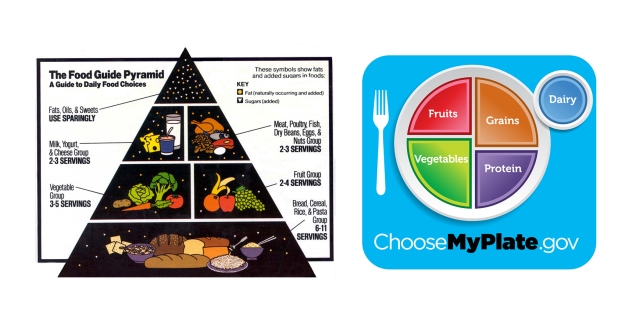If you followed how the food pyramid evolved over nearly 2 decades, you were probably eating your way toward poor health and obesity. The 1992 version had been influenced by powerful food manufacturers and encouraged the overuse of certain foods, while the last version developed in 2005 was too vague.
That all changed in 2011 when the United States Department of Agriculture replaced the pyramid with something we use every day – a simple plate. The abstract term – servings – has been replaced with a visual of five food groups represented in percentages of a plate and a glass.
But like many, you might still have that pyramid stuck in your head, influencing what you eat – and how much. Over the next month, we’ll compare the myths of the old food pyramids with the reality of the new MyPlate created by the USDA.
We kick off the first week with both the foundation and peaked-pinnacle of the pyramid.
Grains
Food pyramid – If ever you were into carb-loading, the old food pyramid was probably your best friend. At its very foundation was the notion that you needed to eat up to 11 servings of bread, cereal, rice and pasta. If you followed it, you could have consumed more than a half loaf of bread or 11 tortillas – none of which are healthy amounts. It also didn’t mention what kinds of grains were important and which to avoid.
MyPlate – Color-coded in light brown and representing 30% of the plate, this new MyPlate recommendations for grains emphasize that grains are an important part of your diet. The new guidelines divide grains into two main groups – whole grains and refined grains.
Whole grains contain the entire grain kernel, including the bran, germ and endosperm. They include foods made from:
- Whole-wheat flour
- Bulgar (cracked wheat)
- Oatmeal
- Whole Cornmeal
- Brown Rice
Refined grains have gone through a process to give them a finer texture and increased shelf life. This also removes the bran and germ where most of the nutrients and fiber are. These foods include:
- White flour
- Processed oatmeal
- White bread
- White rice
Remember – At least half of your grains should come from whole grains.
Sugars
Food Pyramid – The top section of the previous pyramids had a shared space for sweets – plus fats and oils – which it simply defined as added sugar. But all sugars are not created equal. The food pyramid did not explain the difference between natural and processed sugars.
MyPlate – MyPlate doesn’t feature a section where processed sugars are allowed. Actually, the USDA now categorizes what is described as processed – empty – sugar calories, including:
- Cake
- Cookies
- Pastries
- Donuts
- Sodas
- Energy drinks
- Sports drinks
- Fruit drinks
- Ice cream
Foods with natural sources of sugar are more nutritious and loaded with fiber, plus a host of antioxidants. Here are better alternatives when it comes to enjoying sweet treats:
- Fresh fruit
- Dried fruit
- Fruit juice
- Honey
Remember – No matter how good these foods are for you, all sweet foods are naturally higher in calories and should only be eaten in moderation.
For more information about MyPlate and eating the right amounts of nutritious foods, visit www.choosemyplate.gov.
Sources:
http://www.disabled-world.com/artman/publish/food_pyramid.shtml
http://www.nursingdegree.net/blog/746/10-most-pervasive-food-pyramid-myths/
Related Articles
Replacing the Food Pyramid With MyPlate – Part 2
Replacing the Food Pyramid With MyPlate – Part 3
Replacing the Food Pyramid With MyPlate – Part 4

Join the Discussion
0 Comments